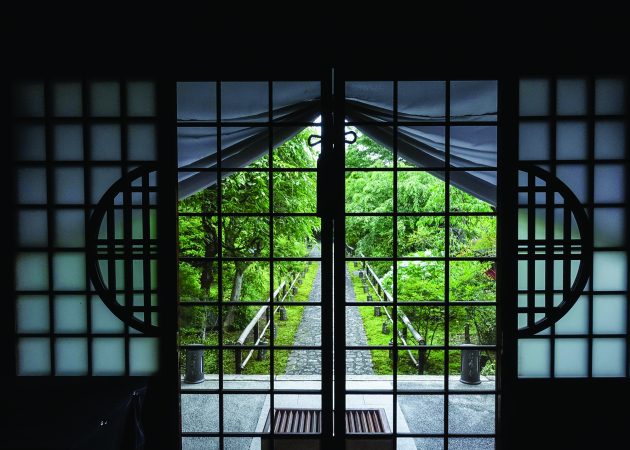
Frozen pea and potato chip casserole. Long before I came to Japan, that dish, symbolic of all those Family Potluck church dinners of childhood, had cemented in my mind the basic incompatibility of religion and good food. Years, later, the experience of Japanese temple food, or shojin ryori, came as a revelation to me; a revelation that continues through many subsects, each with its own delightful culinary dogma.
One especially inspiring communion began on a balmy day as three friends and I walked through the gate of a Kyoto temple called Kanga’an, and hammered on the suspended wooden board by which visitors announce their arrival. Gracious kimono-clad women appeared and led us to an elegantly furnished room facing on the garden. We sat awaiting our gastronomic adventure, sipping plum wine and watching cats and praying mantises frolic among the berry-laden bushes of late summer. Then the sliding doors were pulled back and a succession of platters were brought in, several of them looking like ikebana sculptures. Our meal had begun.
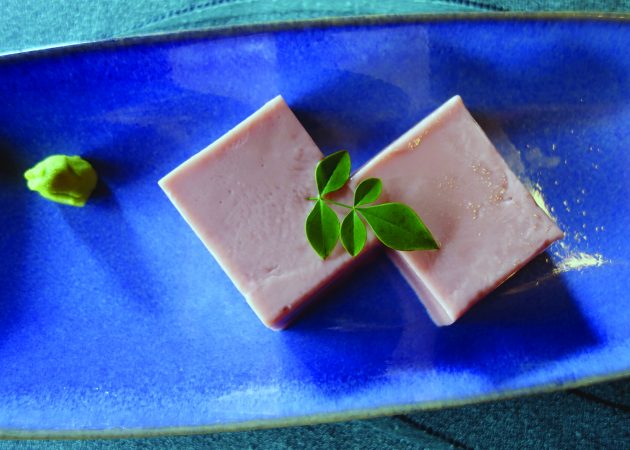
Shunkan, yan’u, unpen, sume… the names on the menu had meant nothing to me, and little even to my Japanese companions. Some things were familiar like eggplant dengaku and — what was that? Spying what appeared to be slices of raw tuna, I picked one up with my chopsticks, bit into it and found that I was eating konnyaku (the jellied starch of a plant called devil’s tongue)—red konnyaku, a specialty of Omi-Hachiman in Shiga Prefecture, we were later told. Next I picked out a pink and white tidbit that I supposed was fish paste. Foiled again: it was a vegetable (nagaimo, a type of yam) that had been cleverly tinted in the same manner as common kamaboko. At this point my friends were carefully analyzing a small whitish slice of something wrapped in kelp. “I know!” said Kumiko at last. “It’s abalone.” “Ahhh,” we all murmured, for it did indeed resemble abalone sashimi, but this too turned out to be nagaimo.
“Guess what you just ate,” said Jin a minute later. Having by now dropped all suspicions of being led beyond the vegetable realm, I thought I had eaten nama-fu (uncooked wheat gluten). “That is sudare-fu,” he announced with some satisfaction, pointing to the sudare (reed screen) that was protecting us from the early afternoon sun. “That’s what it was made from.” I wasn’t quite sure how to feel about eating the gluten of a sunshade, but it had tasted quite palatable.
Some dishes had us completely stumped. We later found that much of our meal had no counterparts in common cookery, but owed their existence to the playful imagination of the temple chef. Hers was a particular brand of the type of shojin ryori prepared by the Obaku sect, called fucha (literally, tea for the public) ryori.
Both of the pieces de resistance were spectacular in their own ways. The first was correctly identified by Sano-san, a fisherman and restaurateur, as an imitation of unagi no kabayaki (split and broiled freshwater eel). It was actually made of tofu (bean curd), gobo (burdock root) and nori (laver, a type of seaweed). To my mind, it exemplified the two main faults in fucha ryori: a tendency to excessive sweetness (shared by many other styles of Japanese cuisine) and an occasional surplus of the cooking oil used for deep-frying. Yet I must admit, it was an impressive creation. Then came a mock chestnut, made from deep-fried chasoba (buckwheat-and-green-tea noodles). Inside was a filling of mashed chestnut and sweet potato, unsweetened. It was delicious, a striking combination of completely natural flavors and a coup for assari shita (made simple) cuisine.
We had many other vegetarian delicacies that day, including an excellent sesame tofu, one of my favorites,and by the end of the meal we were rather stuffed. It had been a memorable meal in many ways, and I became interested in the background of Kanga’an and its distinctive and delicious food.
Kanga’an is a temple of the Obaku sect, a subdivision of the Rinzai sect, which is a branch of Zen Buddhism. It was established in the early 17th century, just after the Obaku sect had spread to Japan from China, in what had previously been an imperial retreat, near the Kuramaguchi entrance to the city.
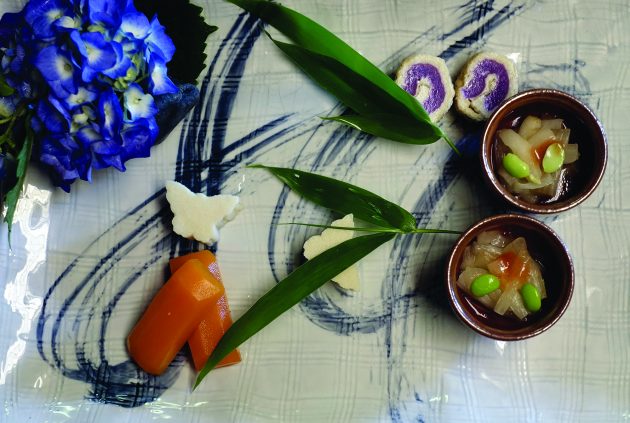
I read in a guidebook that Kanga’an is a nunnery, but I gather that’s not true…
The an in Kanga’an doesn’t mean temple or monastery, it means retreat. It used to be an imperial retreat. Therefore I should not be referred to as an abbess, as some books would have it.
Is it unusual for a woman to be the head of a temple?
Not at all. Besides the abbesses of nunneries, there are female monzeki [descendants of the imperial family who are heads of temples] and there are women who inherit ordinary temples such as myself. My father was the proprietor of this temple. I had an older sister, but we were about as far apart in age as parent and child. She married the priest of a temple near Osaka. I had been living here since I was a child, so I succeeded my father as head of the family.
When did Kanga’an begin to serve fucha ryori to the public?
It began about eight years ago. Before that, we used to invite guests over once or twice a year for a special meal.
What led you to having guests for meals?
It’s a matter of temple upkeep. The old system of the emperors and daimyos and shoguns is gone. Of course we still have the emperor, but it is no longer possible for a temple to receive a stipend as we once did, so we have to handle the upkeep by ourselves. This temple is old and falling down. There are a tremendous lot of things that have to be done, fixing leaks in the roof and so forth; and also maintaining the garden and shrubbery. It was up to me, and I thought, “What can a woman do at home?” Well, cooking seemed to be the answer, and having guests come to eat.
You see, in Zen Buddhism we have the three mimokudojo: zazen, bathing and eating. These are considered appropriate occasions for spiritual training. So although serving meals in the temple is a money-making occupation for us, it’s also a kind of spiritual activity. We try to do it well enough that we can be proud, and we are grateful that our customers sincerely enjoy our cuisine.
Is it a tradition of the Obaku sect for the head of a temple to be personally involved in the cooking?
All the priests of the Obaku sect have to attend the head temple [Manpukuji, near Uji] for a time, and one of the things they have to do is spend time in the kitchen area, which is called the tenzo, and learn fucha ryori. Whether or not they serve meals when they return to their own temples is up to them. But many priests cook in their homes or temples, and in every temple the basis of fucha ryori is the same, even though each priest might cook in a different way. The shapes might be different, the colors might be different, the tastes might be different.
How did you learn fucha ryori?
I didn’t learn at the head temple. I learned from my father and mother and I studied at other places. When I was little I never did anything. I was like a doll. I was brought up as if in a dream. I only had my okeiko [cultural studies considered appropriate for women], and I went to school too. To tell the truth, I didn’t think I was able to work diligently and make a living like this, preparing meals for customers. But when I was forced to support the temple, it felt like I was cut out for this after all. I never would have believed I could work so hard, day and night!
How does fucha ryori differ from other styles of shojin ryori?
Fucha ryori was brought directly from China, so it’s a little richer in taste. The taste of the other sty les of shoj in ryori is generally plain and simple. And in fucha ryori the food is made to resemble something completely different, like eel, fish paste or chestnuts. It’s an enjoyable style of cooking, full of variety. But it is for a minimum of four people. They sit opposite each other and use their own chopsticks to take food from the central platter, without toribashi or modoribashi [chopsticks for taking and replacing food on a platter].
I know that no animal products are used in fucha ryori. Are there any other limitations as to the ingredients?
We use almost all kinds of vegetables, but not garlic, leeks or onions. They’re very strong and spoil the taste of the other materials. Only vegetables that harmonize are used.
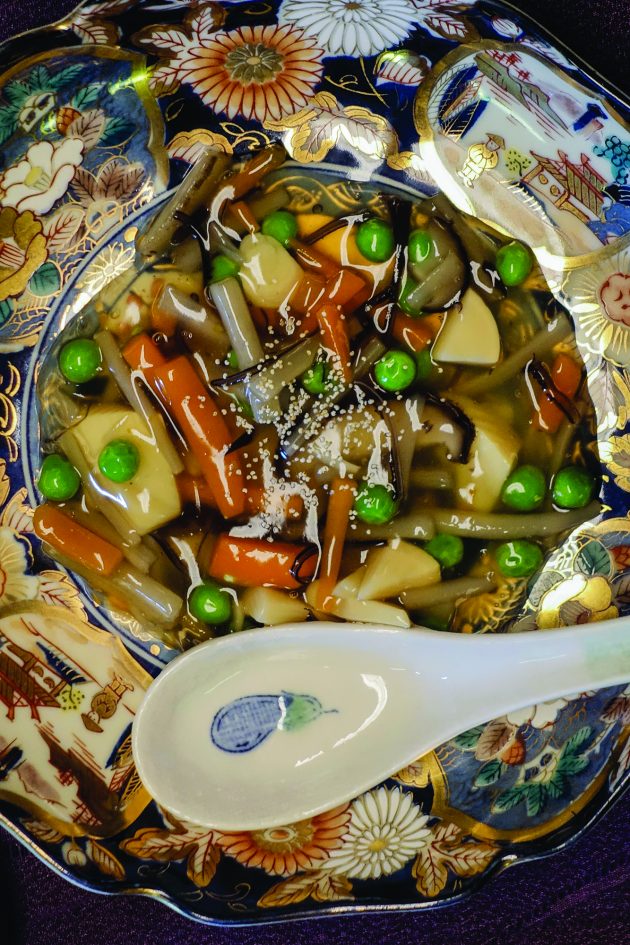
Would you say that fucha ryori typically has a very mild flavor?
Yes, perhaps. Unseasoned tofu and vegetables have a rather poor flavor. If you say “temple food” or “tofu and vegetables” to people, the image they get is one of old-fashioned, unappetizing, tasteless, dreary food. It’s only recently that some people have come to understand that shojin tyori is delicious and that the temple is a bright, fresh and beautiful place to eat. The people we have working for us here are all young, in fact we have an unusually young group, and because of that the flavor of our cooking is a little stronger than the usual.
Where did you get your recipes?
My father taught me the basics, my mother taught me the flavoring, and I added my own preferences to that, as well as my own inventions. It’s a mixture of everything.
What are the aesthetic principles behind the appearance and the taste of fucha ryori?
It is made with shapes and colors and spaces, it’s a balance of many things. I guess you’d have to say it’s … a sense.
One dish that I had seemed to resemble a tray landscape. Have you been influenced by tray landscapes?
I just wanted to give the feeling of looking out at the garden, and then seeing the garden on the dining table.
The quantity of food available to the average person in Japan has certainly increased since the war, but what do you think about the quality? What do you think of the trend toward fast foods?
My honest opinion as to the health effect of additives in instant foods is that after some decades, nothing bad has been found. I know many people are very worried about this, but it just isn’t true that we are eating something bad or poisoned. So I don’t think we have to completely avoid instant foods. On certain occasions I find them convenient, with many good points. However much you may say that this or that is bad for you, nobody lives much more than a hundred years anyway.
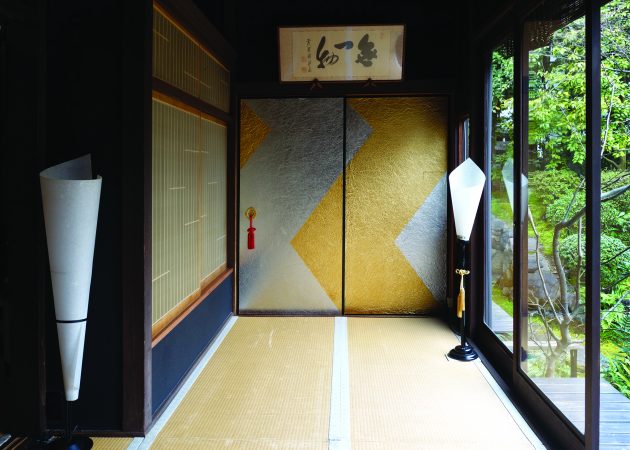
What role do you see for fucha ryori in the Japan of the future?
It has many merits. It is an inherited tradition. These days they’re calling soybeans “meat from the garden”, because it sounds more congenial I suppose. Isn’t it a good idea to take another look at the things that people of the past have tried and found to be excellent?
As a Buddhist, can you say that there are purposes for eating other than to sustain physical existence?
There are five precepts about food, called gokan no ge. The first is Kono tasho o hakari kono raisho orhakaru. It refers to the distance that the food travels from the place where it is grown to the place where it is served and eaten. It reminds us of all the transport and hard labor that’s involved. To put it simply, you shouldn’t be discontented with the food.
The second one is Onore ga tokugyo no zenketsu o hakatte ku ni ozu. It means that you should think about whether you’ve worked enough to be entitled to the food you’re eating. You should ask yourself,
“What did I do to deserve this food.” It’s the idea of reflecting on ourselves.
The third is Shin ofusegi toga tonto o hanaruru o shutotsu. This means that you are not supposed to say you don’t like certain foods, and you shouldn’t become addicted to eating only certain things.
The fourth is Masa ni ryoyaku o koto to sunt wa gyoko o ryosen ga tamenari. We must eat. Our bodies are made from the food we eat. Even in spiritual training of course you must have a body to do it in the first place. So you should be thankful for the food that you receive; it’s like medicine for your body.
The last precept is Do gyo ojozen ga tame ni masa ni konojiki o ukebeshi. This means that although the Buddha’s road is very long, by having this meal you’re making the effort to go one step closer. This is what the unsui [zen trainee] says when he eats.

Photos by John Einarsen